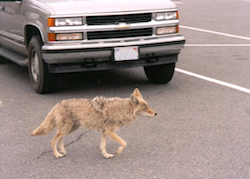SEJournal Online is the digital news magazine of the Society of Environmental Journalists. Learn more about SEJournal Online, including submission, subscription and advertising information.
TipSheet: Covering the Coyotes in Your Backyard
Forget the old stereotypes of coyotes howling in some far Southwestern desert. Today, there are coyotes in almost all of the 50 states. In fact, suburbanites in Bethesda, Md., have spotted coyotes in their backyards in the last several years.
That means no matter where you live, there is probably a story about coyotes near you. While local TV news may do the story on the housewife worried about coyotes eating her cat, environmental journalists can find many stories about the changing boundaries of human settlements and nature.
The news in recent decades is that coyotes — once found mostly west of the Mississippi River — have resettled into areas of the Eastern United States where they were not previously seen. It’s worth asking why that is and what it portends.
First things first. Yes, technically a coyote could eat your cat. Or your small dog. But it probably won’t. And it probably won’t eat your toddler either.
Coyotes eat a wide variety of things. Small animals, insects, plants and carrion. That is one of the keys to their adaptability. But as opportunists, they can also eat larger animals like deer or livestock. All things being equal, they’d prefer a rabbit or a mouse.
Second, you may not see them very often, but coyotes are not rare or endangered in the United States. The benchmark IUCN Red List lists them as a species of “least concern.”
 |
| Although coyotes prefer to avoid dense human settlements, they're able to adapt to a variety of habitats, like this urban setting in the Pacific Northwest. Photo: Oregon Department of Fish & Wildlife, Flickr Creative Commons. |
Why don’t we see coyotes more often? They actually appear to prefer places where human settlement is less dense, and may switch to nocturnal habits near humans.
So why have coyotes moved into the eastern suburbs? Despite the desert stereotypes, coyotes can actually adapt to a variety of habitat types. Ecology offers some insights here. It appears that coyotes moved into niches left when some other predators lost conflicts with humans — such as foxes.
But that’s not all. Genetic evidence now suggests that coyotes have interbred with wolves to some extent as they moved east, making them more aggressive.
In killing of coyotes, cruelty an issue
A big part of the coyote story involves human values. Ranchers and farmers consider them nuisances or enemies when they prey on livestock, and seek to kill them. Hence government funding of USDA’s Wildlife Services.
The controversy arises partly from attitudes and methods involved in coyote-killing.
This year’s headlines included an incident in Idaho where a device meant to poison coyotes instead harmed a boy and killed his dog. The so-called M-44 device, similar to a pipe, was planted in the ground by USDA’s Wildlife Services. Triggered by contact, it sprayed a lethal dose of cyanide.
The likelihood such a device would kill “non-target species” seems high. USDA has temporarily stopped using the devices.
Is it worth a human life to kill a nuisance predator? Ranchers are not the only U.S. interest group who get a say on this question.
Groups opposing cruelty to animals also feel strongly about hunting, trapping and destruction of coyotes. Liza Gross of KQED did a telling story in 2013 about seeing a fence in Northern California where a dead coyote had been hung by a rancher on every post.
Animal cruelty opponents have taken issue with organized contests to promote killing of coyotes. While wildlife managers view such contests as a way to control populations of coyotes (and their prey), animal groups find them unnecessarily cruel.
If you cover sightings of coyotes locally, you may want to include proven methods (other than killing) for minimizing human-coyote conflict.
Possible story sources
- Call your local animal control office, if you have one in the county or city government. Or try to find a commercial wild animal (or “pest”) control service that may deal with coyotes.
- Try to find any commercial or hobby trappers in your area. Search on “fur” as well as “trapping.” Look for clubs, websites, listservs and suppliers (they are sometimes also hunting suppliers). Talk to the National Trappers Association.
- Check in with your state department of natural resources — the name may vary from state to state — but you probably want the agency that licenses hunting. Does your state allow hunting or trapping of coyotes?
- Talk to the U.S. Department of Agriculture’s Wildlife Services, the ones who shoot, poison or trap predators that harm livestock. There is a national office, but you may find that the cutting edge is in the network of state offices.
- Talk to local and national conservation groups who are specifically interested in coyotes. Key among them is Project Coyote. Others are Predator Defense, the Humane Society and the Wolf Conservation Center in New York.
* From the weekly news magazine SEJournal Online, Vol. 2, No. 16. Content from each new issue of SEJournal Online is available to the public via the SEJournal Online main page. Subscribe to the e-newsletter here. And see past issues of the SEJournal archived here.













 Advertisement
Advertisement 



